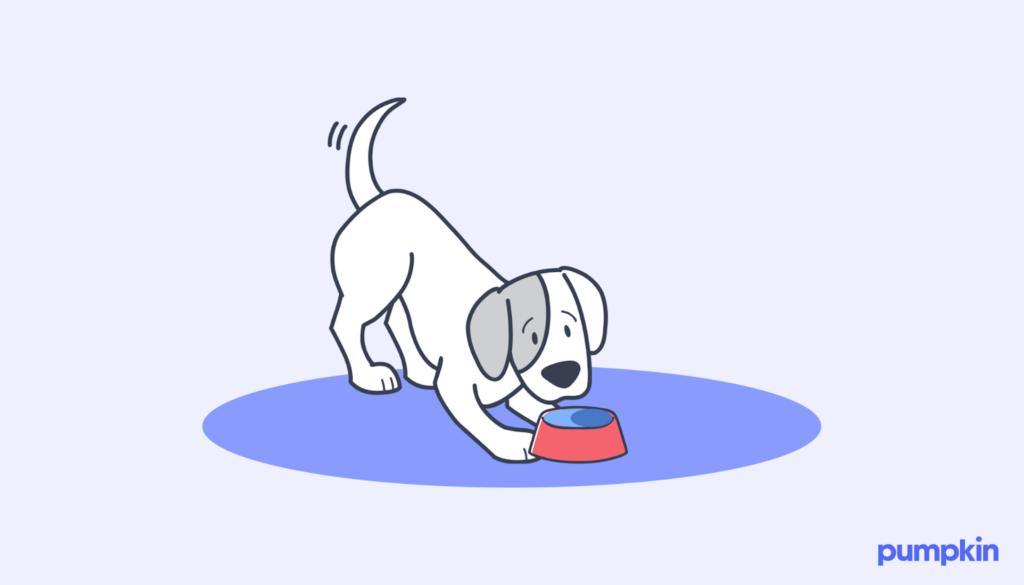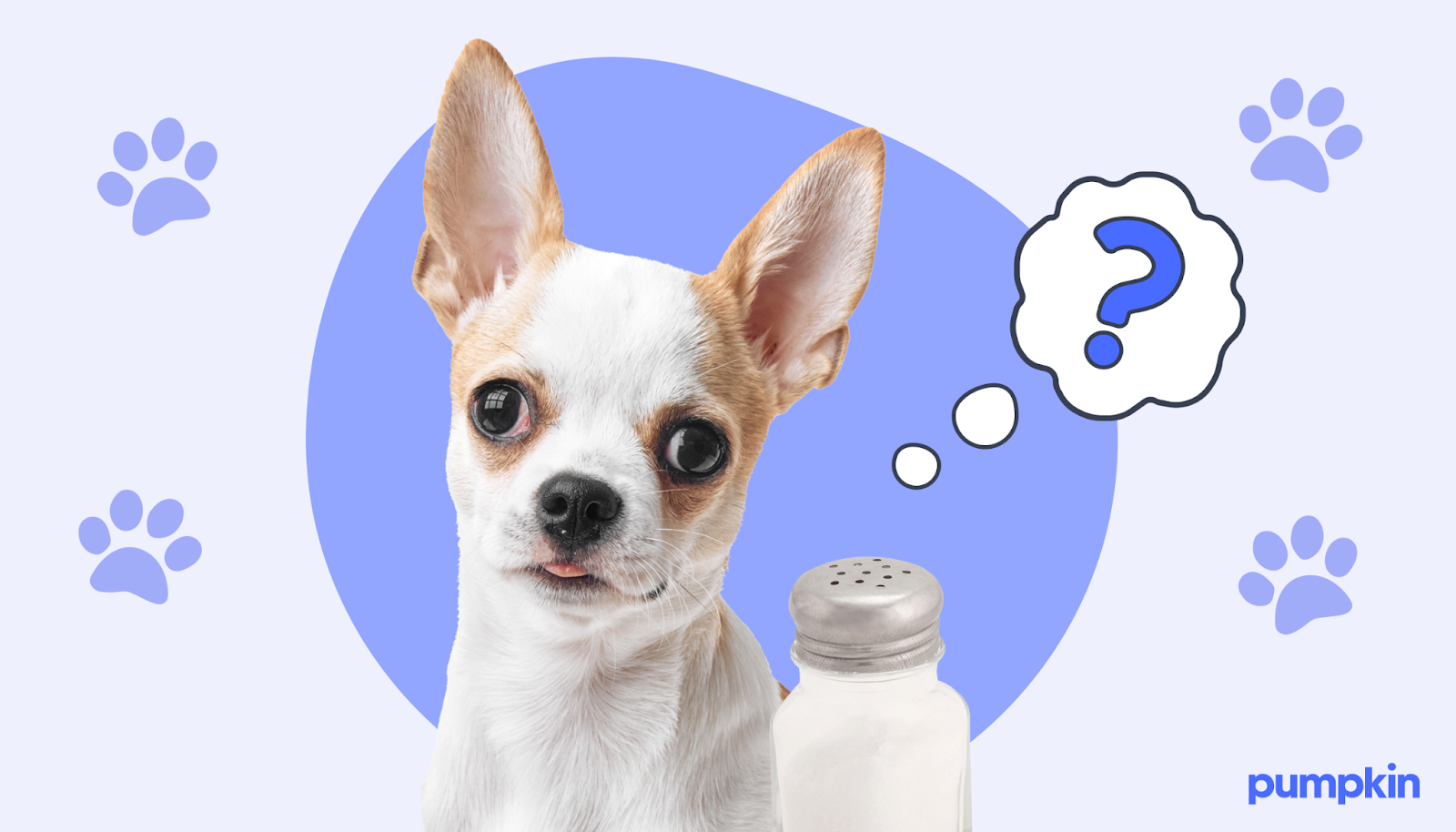Key Points:
- Yes, dogs can have salt in their diet, but excessive intake can be harmful. Under no circumstances should your dog be eating table salt or drinking salt water.
- Salt is essential for balanced electrolyte levels and proper bodily functions in dogs.
- High salt consumption can lead to salt poisoning and symptoms such as vomiting, diarrhea, dehydration, and seizures.
Does your dog like to eat any human food they can get their paws on? Even the good-est of good dogs have a penchant for sneaky snacking. And if your dog just scarfed down a plate of french fries or some other salty fare, you may be wondering if dogs can eat salt safely.
It’s actually a complex question. Salt is essential for your dog’s diet, but too much can lead to salt poisoning and other health problems.
So, before you offer your good boy or girl salty foods, let’s look at the effects it can have on your dogs’ health and discuss just how much is too much.
Salt and sodium: What’s the difference?
It’s no secret that salt is in almost everything we eat, and it’s generally understood that some sodium is vital to our dogs’ diets. However, salt and sodium technically reference different things.
Salt is sodium chloride, a crystal-like compound found in nature, whereas sodium is a dietary mineral found in salt. Salt and sodium make up two of the electrolytes our tail-waggers require in their daily diets.
When dogs ingest sodium, it turns into ions inside their bodies. Ions help regulate fluid levels, blood pressure, and blood volume. It also works with potassium to power nerve impulses and muscle contractions.
The effects of salt and sodium on the canine body
When dogs have insufficient amounts of salt or sodium, Hyponatremia can occur. This happens when dogs lose fluids through vomiting or diarrhea and become lethargic.
On the flip side, when a dog consumes too much salt, salt poisoning can occur. We call this hypernatremia meaning the sodium levels in the blood are too high. This happens when a dog ingests large amounts of salt, sodium, or has insufficient water intake. As muscles and tissues release fluids to level out the sodium levels in your dog’s blood, the kidney senses high levels of fluids and sodium in the bloodstream and excretes them into urine, leading to dehydration.
Tip: Some dogs with Addison’s disease may be at higher risk for salt poisoning due to their inhibited ability to regulate electrolytes and fluids.
When a dog’s muscles lose too much fluid, they become stiff, which may cause difficulty walking. When a dog’s brain loses too much fluid, you’ll notice a lack of coordination and may see tremors or seizures occur. All of these symptoms are cause for immediate concern.
This all sounds scary, but salt poisoning usually happens only when dogs ingest an extreme excess of salty foods. So the question is, what is a healthy salt intake for dogs?
When does salt intake become dangerous?
The difference between whether salt is safe or dangerous lies in how much your pup ingests, and the precise amount will vary on your pup’s breed, size, and overall health. Generally, dry dog food for adult pups should contain 0.08% sodium and 0.12% salt.
What does this mean in practice? As a rule of thumb, follow the 90/10 rule, which states that 90% of your dog’s food should come from their dog food, and the remaining 10% from treats.
While the occasional french fry or salty cheese won’t trigger salt poisoning in dogs, stick to dog-safe treats like fruits, veggies, lean meats, and commercial dog treats whenever possible. Instead of offering your dog some of your favorite salty food, try carrot slices, cucumber rounds, or a blueberry. Other safe snack ideas include plain popcorn, turkey, and peanut butter — all in moderation, of course.
Pet Pro Tip: If you have a dog that is prone to ‘snacksidents’ – you should consider getting a dog insurance plan as soon as possible. It can help you afford the best care in the future by covering eligible vet bills for digestive illnesses, toxic ingestion, and more.
Salty foods and products to avoid
Manufacturers formulate commercial dog food to meet the daily salt requirement needed for a dog’s health. When a dog exceeds that limit — by gorging themselves on some unattended pretzels or salty chips, for example — health problems can occur. Some common household products also contain high levels of sodium or salt.
These problems can be anything from mild stomach upset to dehydration. In extreme cases, it could result in salt poisoning, which can lead to death if left untreated for too long.
Here are some of the most common foods and products to avoid if you’re worried about salt toxicity in dogs:
- Salt water (beware ocean water or tinned fish served in brine)
- Fast food
- Snacks such as potato chips, pickles, french fries, pretzels, and crackers
- Paintballs
- Bath salts
- Sea salt-coated snacks
- Table salt
- Rock salt used on icy roads and sidewalks (this is a hazard when dogs walk on it and lick their paws.)
- Highly processed meat such as sausages, lunch meats, and hot dogs
- Some cheeses
- Canned vegetables, soups, or prepared canned meals
- Pizza (Not only does it contain large amounts of salt, it can also contain onions and garlic, which can cause deadly health issues.)
How to spot salt poisoning symptoms
When your pooch consumes too much salt, the symptoms and damage can develop quickly. For this reason, you should act fast.
Signs of salt poisoning include:
- Diarrhea
- Vomiting
- Excessive thirst
- Swollen abdomen or fluid accumulation
- Excessive urination
- Tremors
- Stiffness or incoordination
- Seizures
Call your veterinarian immediately if you notice any of these symptoms and suspect salt is the culprit. Be prepared to give information about your dog’s weight, age, and the quantity of salt ingested.
Flushing the excess sodium from the system is important. Be sure to offer your dog a lot of fresh drinking water to help restore fluid loss and prevent dehydration, and to help minimize cell damage when salt poisoning occurs.
You can also call the Pet Poison Helpline or Animal Poison Control. Available 24/7, their experts can help you determine next steps and whether veterinary care is needed.
Salt toxicity treatment
If salt toxicity is suspected, your vet will likely analyze blood count, blood gases, blood chemistry, and urine to determine the salt levels in your dog’s body.
Your vet may also perform an EKG to measure electrical impulses in the heart as well as a CT Scan, MRI, or ultrasound to assess potential damage to the brain, heart, and lungs.
When your dog’s results are in, they may need to be held for further monitoring and care. Care might include IV fluids, electrolyte monitoring, and any supportive medications the veterinarian deems necessary. Treatment and prognosis are determined by the overall health of the dog, sodium blood levels, and the time since ingestion.
If your dog needs to stay at the vet for further care, don’t panic: It can take time to heal from salt poisoning. When too much salt enters a body, getting rid of it is a slow process. If sodium levels drop too quickly, heart attacks or brain swelling can occur, so it’s best to let your vet observe your canine companion until they’re feeling better.
How to encourage your dog to drink water

Your dog should always drink plenty of water, but it’s an especially great way to avoid an overload of sodium. Some dogs will immediately go for a bowl of clean water, but others need to be coaxed.
Here are some tips and tricks to make water more enticing:
- Add sodium-free broth to their water
- Clean their water bowl regularly
- Move their water bowl to a new location or add a few more throughout the house
- Use a squeeze bottle to encourage fluid intake (if your vet recommends it)
- Mix a little water into your dog’s kibble
- Offer hydrating snacks, such as watermelons and cucumbers
- Consider getting a pet fountain with flowing water
While all of this sounds nerve-wracking, (and it certainly can be) having the right information and resources at your fingertips can make all the difference.
FAQ: Dogs and salt
- https://www.aafco.org/wp-content/uploads/2023/01/Model_Bills_and_Regulations_Agenda_Midyear_2015_Final_Attachment_A.__Proposed_revisions_to_AAFCO_Nutrient_Profiles_PFC_Final_070214.pdf
- https://www.britannica.com/science/ion-physics
- https://www.ncbi.nlm.nih.gov/pmc/articles/PMC4895431/
- https://www.cliniciansbrief.com/article/hyponatremia
- https://vetrica.com/addisons-diseasehttps://lyka.com.au/blog/the-risk-of-high-salt-content-in-dog-food
- https://www.northeast-vet.com/site/pet-care-blog-plains-vet/2021/01/25/dehydration-in-dogs-causes-symptoms-treatment
- https://www.hillspet.com/dog-care/nutrition-feeding/risks-of-excessive-salt-intake-for-dogs
- https://www.msdvetmanual.com/toxicology/salt-toxicosis/salt-toxicosis-in-animals
- https://bracpet.com/blog/dogs-have-taste-buds/




